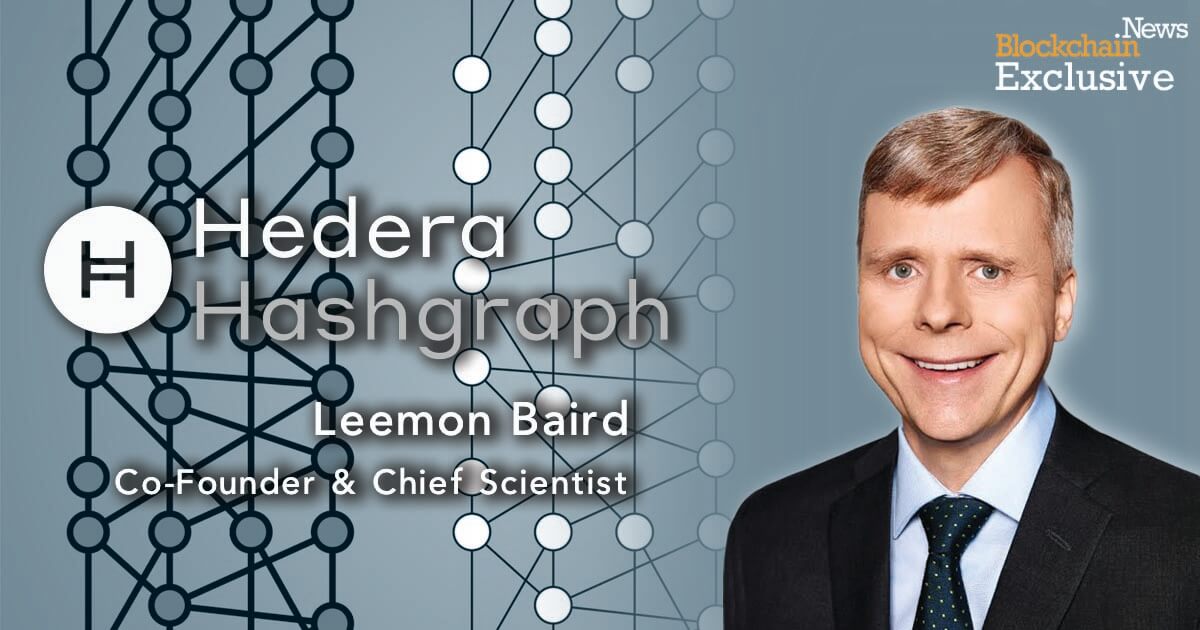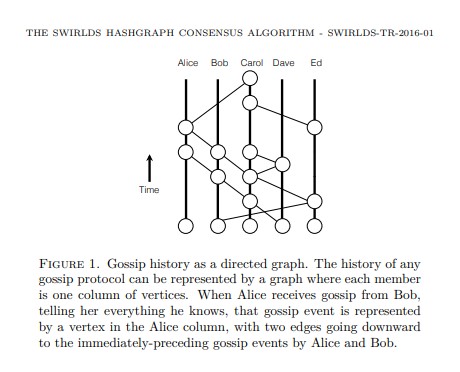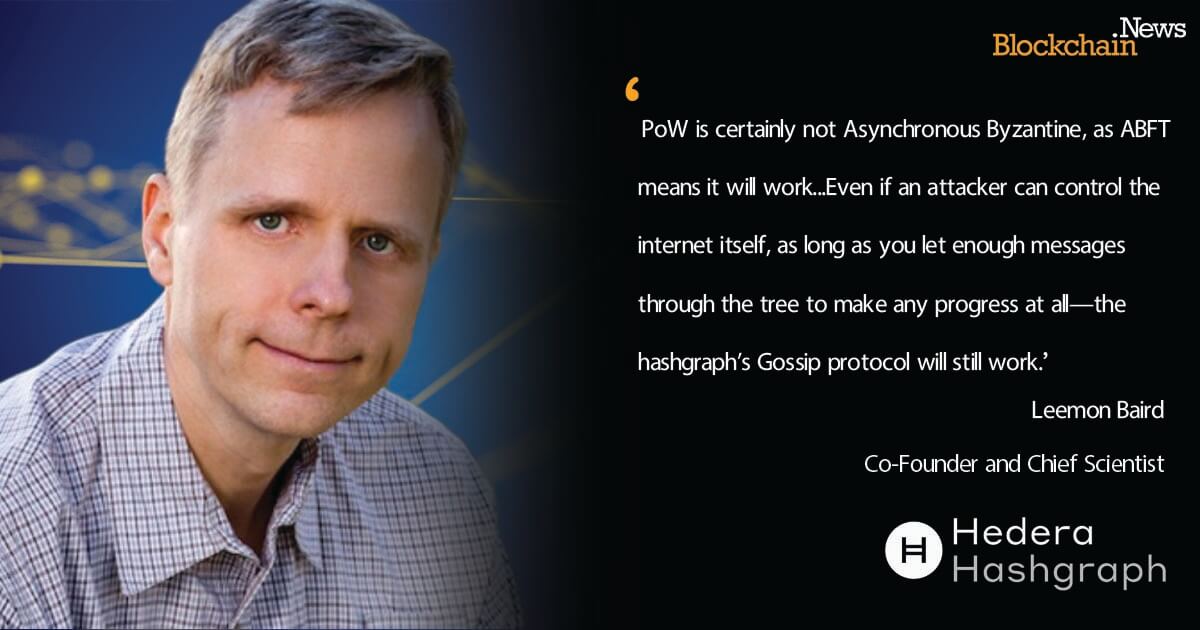Hedera Hashgraph Chief Scientist Dr. Leemon Baird—Defeating the Byzantine Generals and Bringing a Layer of Trust to the Internet
Hedera Hashgraph is a decentralized public network built to support developers and decentralized applications, with a publicly stated mission to bring a layer of trust to the internet.

Hedera Co-Founders Mance Harmon and Dr. Leemon Baird invented and developed the hashgraph algorithm and Hedera public distributed network—which is fast being recognized as an alternative public ledger technology that solves the fundamental issues that are currently preventing blockchain from achieving mass adoption.
In our exclusive interview with Hedera’s Chief Scientist and Co-Founder Dr. Leemon Baird, Blockchain.News gets the details on how Hedera Hashgraph achieves Asynchronous Byzantine Fault Tolerance, the growing Hedera Governing Council and the use of the Hedera Hashgraph DLT to prevent coupon fraud.
Baird and Harmon
In the 1990s, Baird and Harmon were working for the US Air Force conducting research in machine learning and neural networks intelligence. Baird said, “In 2000, together we started starting companies.”
Baird and Harmon’s first company leveraged a biometric system for authentication on PDA’s like the Palm Pilot—essentially an algorithm that recognized handwriting and allowed users to log in with their handwritten signature. This first venture would go on to be acquired by a Fortune 500 company.
The pair went on to launch several other companies including Blue Wave which was also acquired from them, but it was at Swirlds where Dr. Baird first created the hashgraph, which served as a private decentralized network for enterprise, before they created the public version with Hedera.
Baird and the Byzantine Generals
Baird has always been interested in maths problems, he admits that since childhood they have always demanded his attention and been somewhat of an obsession. One that caught his interest around eight years ago was—is there way for a bunch of computers to come to an agreement super-fast with super high security?
Baird said, “I wasn't really thinking about blockchain, I was thinking about a wider problem of just in general, how can computers agree on things? It's an interesting math problem. I wanted extremely strong security—ABFT which means asynchronous Byzantine fault tolerance and that's an incredibly high bar.”
According to Baird, people have known for 30 years how to achieve ABFT, he explained, “You just have voting systems where computers send tons of messages back and forth to vote on things but it is incredibly slow—so almost no one in the real world ever implements it. I wanted to get the same kind of security, but in something super-fast.”
So in 2012, Baird had his new math problem to solve and he would work on it relentlessly, to the point where he even became convinced that it was impossible. But he could not let it go, “For years it haunted me, it just kept gnawing at me and every now and then I would have to pick it up again and play around with it for a few days, and again I would say, ‘No, I really have looked at this from every direction, it really is impossible’—and I would set it aside."
In 2015, Baird had a breakthrough, he explained:
“When we're talking back and forth to each with messages, if you just add two hashes on your messages — just to remember what the last message was that you sent, and the last message was that you received, you just put a hash on those messages — then when you collect all the messages from everybody, you’d see a complete history of how we talk to each other.”
The process is so simple, that Baird explained, “You could run those old voting algorithms in your head. You actually don't have to do any communication at all. We had achieved ABFT, but with zero communication for the consensus part of it and it was as fast as the internet—you just ‘gossip’ out your information as fast as you can. It was very exciting, and it was from there we started Swirlds.”

Source: SWIRLDS Whitepaper
ABFT > PoW
Baird began his search for a distributed consensus mechanism around 2012, but hadn’t this issue been solved with Bitcoin’s Proof-of-Work blockchain protocol in 2009? Not even close according to the Chief Scientist.
In his quest for fast, secure communication between computers to achieve consensus, Baird asserts, “I never seriously considering proof of work because it's not Byzantine Fault Tolerant—and it’s certainly not ABFT.” He continued, “It's super slow, uses tons of electricity—which means that everybody moves to countries where electricity is cheap which gives you concentrations of miners, which is not really what you want—if everybody lives in the same country, then one government could take it over.”
What does it mean for a network to be BFT? Baird explained, “First of all, we're going to have to have finality in the network, there's going to be a moment when we all have to agree and with proof of work you never have finality—you never all agree.” Baird continued, “It’s all about the Byzantine General’s Problem.”
The Byzantine General’s Problem is a term used to describe a condition where a failure could happen within distributed computing systems where components may fail and there is imperfect information on whether a component has failed. In order to avoid failure of the network, the actors in the system must be able to agree on a unified strategy and come to a final agreement—finality. Bitcoin’s proof-of-work blockchain has been heralded as being Byzantine Fault Tolerant (BFT)—the solution to communicating and achieving consensus in the network, but Baird insists PoW never really achieves finality.
Baird asserted, “PoW is certainly not Asynchronous Byzantine, as ABFT means it will work even if the internet is screwed up in various ways. Even if an attacker can control the internet itself, as long as you let enough messages through the tree to make any progress at all—the hashgraph’s Gossip protocol will still work.”

Speed of Transactions on Hedera Hashgraph
Another issue of the Bitcoin PoW blockchain that left Baird completely unimpressed is the slow speed at which it operates—blocks are created every 10 minutes and the blockchain maxes out at 7 transactions per second which is why it is unable to pick up any momentum as a legitimate payments network.
In contrast, Baird said, “I also wanted our network to be very fast, so instead of 10 minutes per block, I wanted every node to be creating mini blocks per second. Not just one computer, but every computer in the network could be creating many blocks for something which is what we now have and it's very fast.”
Hedera Hashgraph is fast. It is limited only by the bandwidth. If each network node has enough bandwidth to download and upload a given number of transactions per second, the network as a whole can handle close to that many transactions per second. Even a fast home internet connection could enable a Hedera node to be fast enough to handle transaction volume equal to that of the entire global VISA card network.
Baird explained, “We've had experiments, you know, that have been extremely fast, hundreds of thousands of transactions a second. We have intentionally slowed our system down to a mere 10,000 transactions per second.” He added:
“In testing, we can do faster than that. But then we also have third parties that have created mirror computers that are watching our network, we want to make sure that they're able to keep up with us—so at the moment, we've slowed it down to just 10,000 per second, for cryptocurrency transfers and consensus messages, but we can go much faster than that.”
Hedera’s Governing Council
The Hedera Governing Council was set up as a limited liability company that will have up to 39 members, made up of leading global enterprises from diverse industries and geographies. Hedera’s licensing and governance model aims to protect network users by eliminating the risk of forks, guaranteeing the integrity of the codebase, and providing open access to review the underlying software code.
Baird said, “The thing about decentralized ledgers is that it isn’t good enough to just have a good algorithm, you need good governance. You need a way of building trust that more than two-thirds of the nodes will be honest. Because every algorithm can be corrupted if a third of the nodes are dishonest and the attacker can do things with the internet. Every system has that problem, and so you've got to have trust.”
The Hedera Governing Council taps 39 hands-on node runners to govern its enterprise-grade public ledger, the Hedera network, and currently has buy-in from giants of industry such as Google, IBM, Boeing and one of the latest additions is South Korean company LG. Baird promises, “There are a lot of exciting names to come.”
The Governing Council, as the name suggests, governs the network and will decide what features should be in the software; how software is upgraded; how pricing is managed; how tokens are managed etc. Baird said, “They have control of all that and for the moment—we are also having them run the nodes so that you absolutely can trust that the computers in the network are trustworthy. We will over time, go to allowing other trusted parties to run nodes, and maybe even allow anonymous nodes proof of stake.”
Under the Hedera governance model, all Governing Members will have equal voting rights and each Governing Member will serve for a limited term, ensuring that no single member or group of members ever has centralized control of the network. Baird explained, “They are in different countries and have different governance in different cultures. They are also huge companies that have reputations they want to protect so if they were to do anything malicious it will be caught, and it will destroy their reputations—so there is high motivation for them to do the right thing. There's no single government that could nationalize them all and makes them do something bad.”
Baird also discussed his excitement not only for the growing Hedera Governing Council but also for the work some of the members were doing. DLA Piper is one of the largest law firms in the world and was very early in joining the Hedera Governing Council.
DLA Piper is leveraging the Hedera Hashgraph to create a tokenization solution, Baird said, “I’m glad that we have a law firm, but they're also very interested in tokenization and I think that is the future in a lot of ways.” He continued, “Why can't we take assets in the real world—stocks and bonds and real estate and even smaller things like a bottle of wine or a single painting—tokenize them and have tokens in the ledger, that contract reflects who owns it, or even who owns fractions of it. That's an incredibly complicated world because every country has its own laws, so if you want to do tokenization, you really need now to know the laws in all these different countries. You can see why a legal firm would be part of that story.”
The Coupon Bureau & AdsDax
The Coupon Bureau, which includes giants of retail such as Target and General Mills, recently announced it will be adopting Hedera Hashgraph's DLT to prevent coupon fraud as the potential of the technology continues to permeate the mainstream retail space. Baird could not be more excited by the development.
Baird said, “The Coupon Bureau is enormous and through this collaboration, I have learned a lot about the coupon industry—it is rife with fraud, basically it's very easy to Xerox a coupon and rip off a store and it's mainly due to a lack of real-time checking which allows even unique coupons to be counterfeited. The majority of coupons are still checked manually, which is frankly just insane.”
By leveraging Hedera’s Hashgraph, Baird explained, “The idea is that you do it all electronically with controlled mutability, nobody's going to be able to go back and change the past in a bad way, you can guarantee that the same coupon wasn't used twice. Using the Hashgraph DLT offers very strong, anti-fraud measures, and it’s exciting as they really are just enormous—The Coupon Bureau is doing coupons for just about everybody.”
Baird also highlighted exciting use cases for the Hashgraph, in their collaboration with AdsDax—which is a blockchain advertising platform and marketplace that is leveraging hashgraph for fraud prevention. He said. “It’s an enormous problem.”
Baird explained that there is a lack of transparency between advertisers and consumers. Advertisers don’t know if their audience is real and consumer data is used without permission of end-users while middlemen technologies drain money from the supply chain, with some even actively encouraging or ignoring fraud in order to create revenue for themselves.
Baird said, “AdsDax creates more transparency, through a proof of action which is an immutable record of authentic impressions on your promotion or ad—using the system it is near impossible to fake the data that many disingenuous actors leverage to defraud clients.”
The list of collaborations is extensive and Baird also mentioned his excitement to be working with hearo.fm, among others, which is a decentralized music streaming service. Hearo.fm is a Hedera Hashgraph based global marketplace that enables music artists to sell and showcase their music directly to fans via a decentralized platform. Hedera Hashgraph’s technology enables the use of micropayments for streaming music in tokens called JAM tokens which are built on HBARs (Hedera’s native token).
What Crypto is Dr. Baird holding?
We could not let Dr. Leemon Baird escape without asking him what cryptos he was holding. Amused he said, “I am a super conservative investor. I just have mutual funds and super safe extra boring things really. I have invested in HBARs. But before I started this company, I had never invested in any cryptocurrency and I still have not invested in any other cryptocurrency but my own—not even a little Bitcoin.”
To read out past interviews with Mance Harmon, CEO of Hedera Hashgraph please click here.
Image source: Shutterstock

